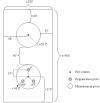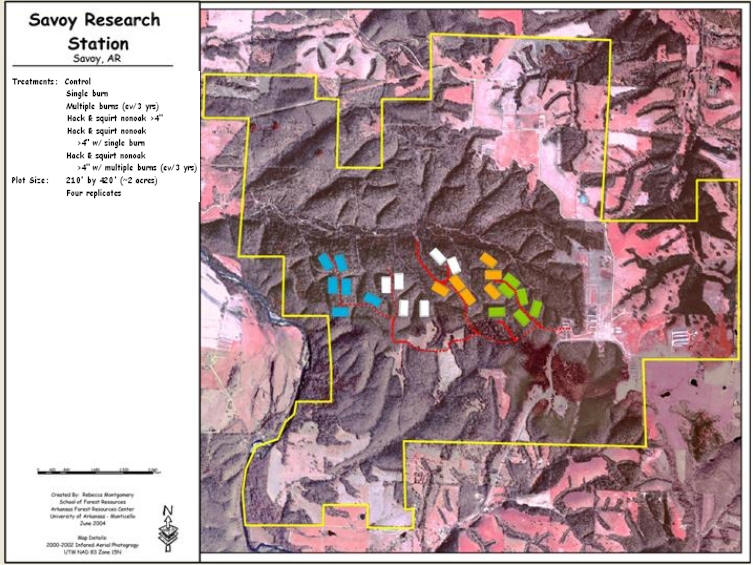Savoy Upland Hardwood Rehabilitation Study
Objectives
This study will evaluate the use of several silvicultural
techniques to rehabilitate an upland hardwood stand at Savoy, Arkansas. The
treatments used will include 1) no treatment (control), 2) repeated spring burns
at 3 year intervals, 3) a single spring burn, 4) hack and squirt all non-oak
stems >4" in dbh, 5) hack and squirt all non oak stems >4” followed by a single
spring burn, and 6) hack and squirt all non oak stems >4” followed by multiple
spring burns every 3 years. Four replicates will be used in this 2 x 3 factorial
design.
Site and Soils
The site is located on the University of Arkansas Savoy
Research and Extension Complex lands in the Ozark Mountains of Arkansas. In 1997
a portion of these lands was harvested using a diameter limit cutting method
which removed all stems (except black walnut) greater than 12" in dbh. Trees
which were harvested at this time were located on easily accessible ridge tops.
Trees near streams were not harvested due to equipment limitations associated
with steep terrain. The resulting stand currently consists of scattered, low
quality trees (including, but not limited to post oak, black oak, and southern
red oak), brush, vines, and some quality black walnut trees. No further
treatment was applied to the site after harvesting.
The terrain of the area is hilly with frequent steep slopes.
The harvest area surrounds an intermittent creek which flows into the Illinois
River. The soils of the site are a combination of Clarksville cherty silt loam
with 12 to 60 percent slopes and Nixa cherty silt loam with 3 to 8 percent
slopes. Low in natural fertility and organic matter, the Clarksville soils are
excessively drained soils and typically located on hill sides, while the Nixa
soils occur along ridge tops in the area. A droughty soil, Nixa soils have low
natural fertility and a fragipan which restricts root penetration at about
14-24" deep. These soils have moderate to severe erosion hazards and equipment
limitations. Important wood crops on these soils include shortleaf pine, eastern
red cedar, black walnut, and red oak. Site indices for red oak, shortleaf pine,
and black walnut located on hillsides are 60-65, while the ridge tops are less
productive with site indices for shortleaf pine 50-55 and eastern red cedar
30-35.
Methods
Plots--Twenty-four
2-acre plots have been established in the harvested areas near roads (for ease
of access) at the study site. Due to plot size and access constraints, not all
plots could be located on similar slopes or aspects. Plot dimensions measure
approximately 210' by 420' and are situated in such a way that a 35 ft buffer
surrounds all plots.
Inside the study plots, two large
(1/5 acre) permanent measurement plots will be placed (figure 1). In these plots
the following items will be measured for all trees greater than 4.0" in dbh: dbh,
total height, merchantable height, grade and species will be taken.
Inside each of the large measurement
plots, three smaller non-permanent plots will be placed. These plots will
measure the regeneration present on the site. These plots will measure 1/300
acre in size with a plot radius of 6.8' and located at three angles from the
each large plot's center (0 degrees from north, 120 degrees from north, and 240
degrees from north). In these plots all woody vegetation greater than 1' in
height, but less than 4.0" in dbh will be measured. The following attributes
will be measured: species, height, and ground-line diameter.
The study is a 2 x 3 factorial
design with two levels of herbicide treatment (control and hack and squirt) and
three levels of prescribed fire (control, single burn, and three burns and
3-year intervals). Plot layout on the Savoy station is shown in figure 2.
Herbicide
treatments-- For the hack and squirt applications, a 50% solution of
Chopper (imazapyr) was applied during the late Summer 2004 to all non-oak stems
greater than 4” in dbh located within hack and squirt plots. Herbicide was
applied prior to leaf translocation so it could be transported to the root
system for maximum kill.
Prescribed fire treatments--Firelines
were plowed during winter 2004-2005. The Arkansas Forestry Commission was
responsible for fireline construction. The first prescribed burning for single
burn treatment and multiple burn plots is scheduled to occur in early spring of
2005. This burn should provide a moderate intensity burn to top kill vegetation
on the site. The multiple burn treatments will occur at 3 year intervals and are
scheduled for 2008 and 2011.
|
 |
Figure 1 Plot dimensions for study plots in the upland
hardwood rehabilitation study at Savoy, AR. Minimum plot radii for
plots are 52.7’ for measurement plots and 6.8’ for regeneration
plots. A minimum 35’ buffer should surround all sides of the study
plot.
|
|
 |
|
Figure 2. Plot layout for Savoy forest rehabilitation
study. |
Basic Supplies
for 2004-2005 Studies
Regeneration
Flagging
(will flag every tree since plots are relatively
small)
| Seedling
|
Flag (30")
|
# needed |
| Green ash |
pink glow |
512 |
| Northern red oak |
red plain |
512 |
| Black walnut |
blue plain |
512 |
PVC
stakes
Corner stakes for each plot corner
69 poles needed
4' pvc per pole
Total of 69 * 3 = 207' of pvc
required (23- 10' sticks)
Tags
for southwest corner of each plot
48 tags needed
Acorn Study
Flagging
(will flag every tree since plots are relatively
small)
| Seedling
|
Flag (30")
|
# needed |
| Northern red oak |
red plain |
73*4 = 292 |
| Sawtooth oak |
blue plain |
73*4 = 292 |
| White oak |
white plain |
73*4 = 292 |
PVC
stakes
Corner stakes for each plot corner
25 poles needed
4' pvc per pole
Total of 25 * 3' = 75' of pvc
required (9- 10' sticks) (yields 2 extra)
Center point stakes for each of the two sub-plots within the main plot
24 poles needed
3' per pole
Total of 24 * 3 = 72' of pvc
required (8-10' sticks)
Tags
for southwest corner of each plot and center of plots
3 per plot for 12 plots = 36 tags
Savoy Study
Flagging
none
PC
stakes
Corner stakes for each plot corner
24 plots * 4 poles per plot = 96 poles
4' pvc per pole
Total of 96 *3' = 384' of pvc
required (32-10' sticks)
Center point stakes for each of the two sub-plots within the main plot
48 poles needed
4' per pole
Total of 48 * 3' = 192' of pvc
required (16-10' sticks)
Tags for southwest corner of each plot and center of plots
3 per
plot for 24 plots = 72 tags
|
Totals |
|
Flagging |
|
Pink glow |
|
500 |
|
$6.05*5=$30.25 |
| |
|
|
|
Red plain |
|
800 |
|
$6.05*8=$48.40 |
| |
|
|
|
Blue plain |
|
300 |
|
$6.05*3=$18.15 |
| |
|
|
|
White plain |
|
300 |
|
$6.05*3=$18.15 |
| |
|
PVC stakes |
|
1/2" diameter |
|
88 sticks@$1.19/stick |
|
$104.72 |
| |
|
|
|
3/4" diameter |
|
88 sticks@$1.24/stick |
|
$109.12 |
| |
|
Tags |
|
48 (regeneration) |
|
in stock |
|
$0 |
| |
|
|
|
36 (acorn) |
|
in stock |
|
$0 |
| |
|
|
|
72 (savoy) |
|
?????? |
|
|
|
Total Estimate
(without Savoy tags) (using 1/2" diameter pvc)
$219.67 |

